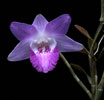|
|
|
|
|
| |
Flasks of
Dendrobium lancifolium 'MC1066' × self |
|
| |
|
|
| |
| Number: |
TN2368 |
| Name: |
Dendrobium lancifolium 'MC1066' × self
|
| Type: |
self (What's that?) |
|
Seed Donor: |
Dale Borders
|
|
Click to Enlarge

Pod Parent Flower |
|
|
|
| |
Culture Notes from Donor: Parent plant: Temperature range I (60-83°F)
For additional origin/habitat information supplied courtesy of
Charles and Margaret Baker, see further below, near the bottom of this page.
|
Temperatures we attempt to use in the lab & greenhouse:
| For Species: |
|
Spring, Summer, Autumn, Winter: days average 83°F, nights 73°F; best fit is Warm 90-70°F
(Source:
Baker's Web OSC) |
|
About the name...
| Etymology of |
Dendrobium |
|
From Greek "dendron" tree and "bios" life.
(Source:
Pridgeon 1992) |
| Etymology of |
lancifolium |
|
From Latin "lancifolius" having leaves shaped like a lance-head.
(Source:
Mayr & Schmucker 1998) |
| Pronunciation of |
Dendrobium |
|
den-DRO-bee-um
(Source:
Pridgeon 1992) |
|
If you would like to direct someone to this web page, please copy and paste this URL into your email:
http://troymeyers.com/d?012368
| Flask Information |
| Availability: |
We have sold all of the flasks for this item. |
| You should: |
Consider getting individual plants or compots instead of a flask.
You can place a "Notify Flask Recipients" Request, and either we or a flask recipient may contact you when plants are available.
You may also place a "Notify Retries" Request, and if an identical pollination (the same parents) is done again, we'll let you know.
You may reserve a flask, but it's very unlikely you'll get one ...this could only happen if we found a flask that we didn't know we had. |
| Yield Estimate: |
660 plants (based on flask surveys done 04/01/2002 )
|
| Plantlet Sizes: |
From many flasks 10 - 70 mm plants (based on flask surveys done 04/01/2002 through 07/29/2002)
From one most recently surveyed flask 50 - 70 mm (07/29/2002)
|
|
You might also want to:
|
View the seed assay for this item.
View items of the same species.
View items of the same genus.
|
| Ordering Information |
| You are not currently logged in. |
|
You must be a registered user and be logged in to reserve a flask or place a notification request. Please log in:
|
|
|
|
|
|
| |
The origin/habitat information below is supplied courtesy of Charles and Margaret Baker
The following information is based on the name of the plant provided by the donor, and assumes that the name is correct. If the plant has been misidentified, then the following information may not be correct.
This text is copyrighted by the Bakers and may not be reproduced without permission.
ORIGIN/HABITAT: Widespread throughout eastern Indonesia, including the
Molucca Islands and the Banda Island group south of Seram. On Ambon,
plants grow on the ground in forest litter along dry water courses at
250-500 ft. (70-150 m). On Sulawesi (Celebes), plants are found at
1250-1950 ft. (380-600 m). In Irian Jaya (western New Guinea), the plants
have been reported on trees in mountain forests in the Arfak Range at
about 6250 ft. (1900 m) and on limestone soils and limestone rocks on
Waigeo Island, Biak Island, and near Jayapura (Hollandia). On Buru
(Boeroe) Island, about 10 miles (16 km) from Leksoela, plants grow on
barren, conglomerate rocks. In other locations, they grow among grass on
dry calcareous ground, or under shrubs on open, sunny, eastern slopes.
More about this information and the Bakers...
|
|
|
| |
|
|
|